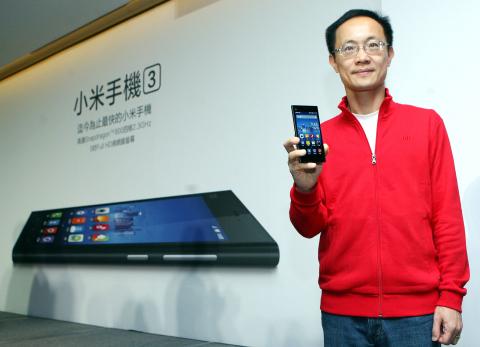Chinese smartphone start-up Xiaomi Corp (小米) yesterday partnered with Chunghwa Telecom Co (中華電信) to sell its phones in Taiwan as part of a push to double its global shipments to 40 million units this year.
Xiaomi last year shipped 18.7 million units worldwide, company co-founder and president Bin Lin (林斌) said during a media briefing to unveil the company’s latest flagship model, the Mi3, in Taipei yesterday.
With its home market its biggest contributor to sales, Xiaomi is aggressively exploring new markets, such as Southeast Asia, to seek further growth, Lin said.

Photo: CNA
Xiaomi, based in Shenzhen, will make its first move by tapping the Singaporean market early next month after Xiaomi Global vice president Hugo Barra first revealed the company’s overseas expansion plans in Taipei in December last year.
Chunghwa Telecom, the nation’s top telecom, joins local peer Far EasTone Telecommunications Co (遠傳電信) in offering the Mi3. Far EasTone sells the phone in a package that includes a screen protector for NT$10,599.
Last year, Far EasTone obtained the exclusive rights to sell Xiaomi smartphones, including the Mi2 and the Red Rice in Taiwan.
Xiaomi sold more than 200,000 phones in Taiwan last year, according to Far EasTone.
Presales of the Mi3 are scheduled to begin today at Far EasTone and Chunghwa Telecom stores.
Consumers can get a free Mi3 by signing up for a Far EasTone service plan with a minimal monthly fee of NT$1,773, or subscribing to Chunghwa Telecom’s service plan and paying a NT$1,143 minimum monthly fee.
The Mi3 will be also available on Xiaomi’s Web site for NT$9,999 from Wednesday next week.
The Mi3 is equipped with Qualcomm’s Snapdragon 800 chip and a 5-inch high-definition screen.
Separately, Far EasTone vice president Maxwell Cheng (鄭智衡) said yesterday that the company plans to purchase 2.5 million smartphones this year, half of them entry-level models.

ISSUES: Gogoro has been struggling with ballooning losses and was recently embroiled in alleged subsidy fraud, using Chinese-made components instead of locally made parts Gogoro Inc (睿能創意), the nation’s biggest electric scooter maker, yesterday said that its chairman and CEO Horace Luke (陸學森) has resigned amid chronic losses and probes into the company’s alleged involvement in subsidy fraud. The board of directors nominated Reuntex Group (潤泰集團) general counsel Tamon Tseng (曾夢達) as the company’s new chairman, Gogoro said in a statement. Ruentex is Gogoro’s biggest stakeholder. Gogoro Taiwan general manager Henry Chiang (姜家煒) is to serve as acting CEO during the interim period, the statement said. Luke’s departure came as a bombshell yesterday. As a company founder, he has played a key role in pushing for the

China has claimed a breakthrough in developing homegrown chipmaking equipment, an important step in overcoming US sanctions designed to thwart Beijing’s semiconductor goals. State-linked organizations are advised to use a new laser-based immersion lithography machine with a resolution of 65 nanometers or better, the Chinese Ministry of Industry and Information Technology (MIIT) said in an announcement this month. Although the note does not specify the supplier, the spec marks a significant step up from the previous most advanced indigenous equipment — developed by Shanghai Micro Electronics Equipment Group Co (SMEE, 上海微電子) — which stood at about 90 nanometers. MIIT’s claimed advances last

EUROPE ON HOLD: Among a flurry of announcements, Intel said it would postpone new factories in Germany and Poland, but remains committed to its US expansion Intel Corp chief executive officer Pat Gelsinger has landed Amazon.com Inc’s Amazon Web Services (AWS) as a customer for the company’s manufacturing business, potentially bringing work to new plants under construction in the US and boosting his efforts to turn around the embattled chipmaker. Intel and AWS are to coinvest in a custom semiconductor for artificial intelligence computing — what is known as a fabric chip — in a “multiyear, multibillion-dollar framework,” Intel said in a statement on Monday. The work would rely on Intel’s 18A process, an advanced chipmaking technology. Intel shares rose more than 8 percent in late trading after the

GLOBAL ECONOMY: Policymakers have a choice of a small 25 basis-point cut or a bold cut of 50 basis points, which would help the labor market, but might reignite inflation The US Federal Reserve is gearing up to announce its first interest rate cut in more than four years on Wednesday, with policymakers expected to debate how big a move to make less than two months before the US presidential election. Senior officials at the US central bank including Fed Chairman Jerome Powell have in recent weeks indicated that a rate cut is coming this month, as inflation eases toward the bank’s long-term target of two percent, and the labor market continues to cool. The Fed, which has a dual mandate from the US Congress to act independently to ensure